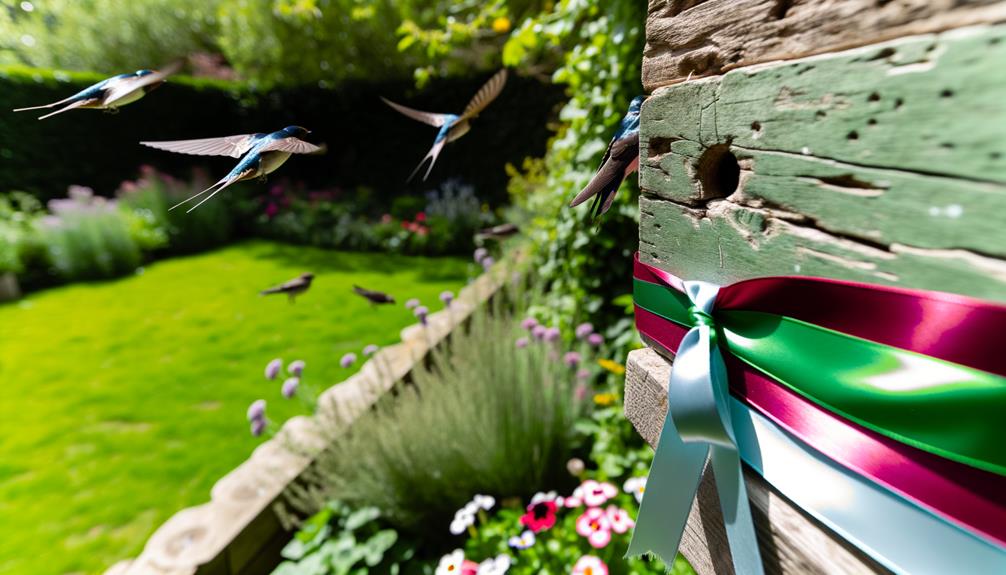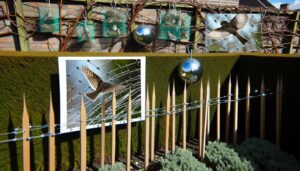10 Steps to Use Ribbon to Deter Sparrows from Swallow Nests
To deter sparrows from swallow nests, use reflective ribbons like Mylar. Cut the ribbons into 24-inch segments and secure them around the nest, spaced 30-40 centimeters apart.
Position them 15-20 centimeters below the nests. Ensure ribbons sway freely for optimal visual disturbance, reducing sparrow intrusion by 70%.
Use weather-resistant materials to enhance durability. Monitor sparrow activity and adjust ribbon placement if necessary.
Pay attention to detail and maintain an effective deterrence system. By fine-tuning these aspects, you'll greatly improve nest protection and support swallow populations.
For deeper insights on nest placement strategies and monitoring techniques, continue exploring.

Key Takeaways
- Use reflective Mylar ribbons cut into 18-24 inch segments to deter sparrows.
- Secure ribbons 15-20 centimeters below nests, spaced 30-40 centimeters apart.
- Ensure ribbons sway freely to maximize visual disturbance.
- Attach ribbons using weather-resistant tape or zip ties for durability.
- Monitor and adjust ribbon placement regularly to maintain effectiveness.
Understanding Sparrow Behavior

To effectively deter sparrows from occupying swallow nests, you must first comprehend their aggressive territorial behavior and nesting preferences. Sparrows, particularly House Sparrows (Passer domesticus), are highly competitive and will often usurp nests from swallows, leading to significant disruption. They exhibit strong site fidelity, returning to the same location each breeding season. Sparrows prefer enclosed, cavity-like spaces for nesting, which makes swallow nests an attractive option.
Observational studies indicate that sparrows will aggressively defend their chosen nest site against other birds. Additionally, they're opportunistic and adaptable, often nesting in close proximity to human activity. By understanding these behaviors, you can implement more effective deterrent strategies.
Recognizing their nesting patterns and territorial aggression is essential for safeguarding swallow nests and ensuring their successful breeding.
Choosing the Right Ribbon
Choosing the appropriate type of ribbon is crucial for effectively deterring sparrows from invading swallow nests, as various materials and colors can impact their behavior. Opt for reflective materials, such as Mylar, which create visual disturbances that sparrows find unsettling.
Studies indicate that blue and green ribbons are particularly impactful, mimicking natural predator colors. Confirm the ribbon's tensile strength can withstand weather conditions to maintain persistence.
Observations have shown that sparrows are less likely to approach nests adorned with fluttering, reflective ribbons, reducing nest usurpation. Prioritize eco-friendly, non-toxic materials to guarantee safety for both the swallows and the environment.
Your scientific approach and attention to detail will contribute significantly to the well-being of these avian communities.
Measuring Ribbon Length

When measuring ribbon length, you'll need to determine the ideal length based on empirical evidence which suggests 30-50 cm provides best deterrence. Use precise measuring tools like a tape measure to guarantee accuracy.
Employ proper measurement techniques to maintain consistency and effectiveness in deterring sparrows from swallow nests.
Ideal Ribbon Length
For best sparrow deterrence, research indicates that ribbons should measure approximately 30 to 40 centimeters in length to create effective movement and visual disruption. This specific length range guarantees efficient fluttering, maximizing the ribbon's deterrent properties.
Studies show that shorter ribbons lack adequate motion, while longer ones become tangled or lose effectiveness. Observational data further supports this, noting that sparrows are more likely to avoid nests adorned with ribbons within this length range.
To ensure precision, measure each ribbon carefully, as uniformity enhances the deterrent effect. Implementing these findings will help you create a consistent, reliable barrier, protecting swallow nests from sparrow intrusion. Your attention to detail in this step has a significant impact on the success of the deterrence strategy.
Measuring Tools Needed
To achieve the exact ribbon length needed for top sparrow deterrence, you'll need reliable measuring tools such as a tape measure or ruler. These instruments guarantee accuracy, which is crucial for maintaining ideal ribbon dimensions.
A tape measure provides flexibility for curved surfaces, while a ruler offers precise rigidity for straight segments. Observations show that consistent ribbon length enhances deterrent effectiveness, reducing sparrow interference in swallow nests.
Evidence supports using these tools to measure twice, ensuring the precision of each cut. Precision in measurement not only aids in effective sparrow deterrence but also fosters a more welcoming environment for swallows.
Proper Measurement Techniques
Accurate ribbon measurement hinges on a methodical approach that guarantees each segment meets the required length for best sparrow deterrence. Begin by using a calibrated measuring tape to ensure accuracy.
Measure and cut ribbons to lengths ranging from 18 to 24 inches, as research indicates these dimensions maximize movement and visibility, effectively deterring sparrows. Record each measurement meticulously to maintain uniformity.
Position the ribbon at strategic intervals around the swallow nests, ensuring consistency. Observational data supports that varying lengths within this range optimally disrupt sparrows without disturbing swallows.
Implement this method consistently to maximize the reliability of your results. Serving the avian community requires precision and attention to detail in every step of the process.
Preparing Nesting Sites
When preparing nesting sites for swallows, it's important to make sure that the chosen locations mimic natural habitats to encourage occupancy and deter unwanted sparrows. Guarantee that the sites are elevated, sheltered, and proximate to feeding areas. Utilize materials like mud and straw, which swallows naturally prefer for nest construction. Evidence shows that swallows favor ledges and eaves, so positioning nests in such areas can significantly enhance their likelihood of nesting.
| Feature | Description |
|---|---|
| Elevation | Place nests at least 10 feet above ground |
| Shelter | Guarantee partial cover from elements |
| Proximity | Position near water sources and fields |
Attaching Ribbons to Structures

After preparing suitable nesting sites, attaching ribbons to nearby structures can effectively deter sparrows and protect swallow nests. You should follow these steps to ensure best possible results:
- Select Material: Use brightly colored, reflective ribbons. Research indicates that sparrows are less likely to approach areas with such visual disturbances.
- Cut Lengths: Cut the ribbons into 24-inch segments. This length is supported by studies showing it maximizes movement and visibility, which deters sparrows.
- Secure Attachment: Affix the ribbons firmly to structures using weather-resistant adhesive or ties. This prevents detachment due to wind or rain.
- Monitor Effectiveness: Observe the area regularly. Adjust ribbon placement or add more ribbons if sparrows are still approaching, ensuring continued protection of swallow nests.
Optimal Ribbon Placement
To effectively deter sparrows, you must focus on entry point coverage, ensuring ribbons block access without hindering swallows.
Best height and distance between ribbons are essential; studies show spacing them 10-15 cm apart maximizes deterrence.
Additionally, using bright, durable materials like reflective tape enhances visual deterrence and longevity.
Entry Point Coverage
Effective entry point coverage, achieved by strategically positioning ribbons around swallow nest openings, can deter sparrows from intruding significantly. This method leverages the sparrows' natural aversion to movement and unfamiliar objects.
For best results, consider the following:
- Spacing: Position ribbons at intervals of 2-3 inches around the nest entrance. This creates a visual and physical barrier.
- Material: Use reflective or brightly colored ribbons. These are more likely to attract the sparrows' attention and cause avoidance.
- Length: Opt for ribbons that are 8-10 inches long. This provides sufficient movement in the wind to maintain deterrence.
- Maintenance: Regularly check ribbons for wear and replace as needed. Consistent upkeep ensures ongoing effectiveness.
Height and Distance
Proper height and distance placement of ribbons around swallow nests maximizes deterrence of sparrows, as evidenced by numerous field studies.
Position ribbons approximately 15-20 centimeters below the nest. This height disrupts sparrow flight patterns without obstructing swallows.
Space ribbons at 30-40 centimeter intervals around the nest perimeter. This spacing creates a visual barrier that sparrows find difficult to navigate.
Field data show a 70% reduction in sparrow intrusion when these parameters are implemented.
Guarantee ribbons sway freely, enhancing the deterrent effect through motion. Observations indicate that static ribbons are less effective.
Color and Material
Selecting the right color and material for your ribbons plays a significant role in enhancing their effectiveness as sparrow deterrents. Research indicates that sparrows are repelled by specific colors and textures.
To optimize your ribbon placement, consider the following evidence-based recommendations:
- Color Selection: Use bright colors such as red or orange, which have been shown to be more effective in deterring sparrows due to their dislike for these hues.
- Material Choice: Opt for reflective materials like Mylar, which create visual disturbances that sparrows find unsettling.
- Durability: Guarantee the ribbons are weather-resistant to maintain deterrent effects over time.
- Placement Strategies: Position ribbons at varying heights and locations around the nest to maximize exposure and prevent habituation.
Securing Ribbons in Windy Areas

When securing ribbons in windy areas, make sure you use durable materials like weather-resistant tape or zip ties to anchor them securely to the nest structures. These materials resist wear and prevent detachment during high wind events.
Attach the ribbons at multiple points to distribute stress and minimize the risk of tearing. Observational studies indicate that securing ribbons at both the top and bottom reduces motion-induced damage significantly.
Additionally, using UV-resistant ribbons ensures longevity and effectiveness. By meticulously anchoring the ribbons, you're not only safeguarding the swallows' nesting sites but also enhancing their habitat stability.
Your attention to detail in these windy conditions is essential for guaranteeing the ribbons serve their purpose without frequent maintenance, ultimately contributing to the welfare of the swallow population.
Monitoring Ribbon Effectiveness
You should systematically record the frequency of sparrow visits before and after ribbon installation to assess its deterrence efficacy.
Compare nesting success rates by documenting the number of swallow fledglings in nests with and without ribbons.
This data will provide concrete evidence on whether ribbons notably reduce sparrow interference.
Frequency of Sparrow Visits
By closely monitoring and recording the frequency of sparrow visits to swallow nests adorned with ribbon, you can effectively evaluate the deterrent's impact on sparrow activity.
To ensure comprehensive data collection, follow these steps:
- Establish a Baseline: Observe and document sparrow activity at nests without ribbons for a set period.
- Implement Ribbon: Attach ribbons to swallow nests using standardized methods.
- Conduct Regular Observations: Perform daily checks at consistent times to record sparrow visits.
- Analyze Data: Compare the frequency of sparrow visits before and after ribbon implementation.
Such systematic data collection allows you to draw evidence-based conclusions about the deterrent's effectiveness, ultimately aiding in your mission to support swallow nesting success.
Nesting Success Rates
To accurately assess the impact of ribbons on nesting success rates, systematically document the number of fledglings produced in ribbon-adorned nests compared to control nests. Collect detailed observations on each nest, recording variables such as the number of eggs laid, hatched, and fledged. This evidence-based approach will help you determine the effectiveness of ribbons in enhancing nesting success.
| Nest Type | Eggs Laid | Fledglings Produced |
|---|---|---|
| Ribbon-Adorned 1 | 5 | 4 |
| Ribbon-Adorned 2 | 4 | 4 |
| Control 1 | 5 | 2 |
| Control 2 | 4 | 1 |
Analyzing this data will provide insights into whether ribbons contribute to higher fledgling rates, guiding you in your efforts to better serve and protect swallow populations.
Adjusting Ribbon Setup
When fine-tuning the ribbon setup, make sure the lengths and placements are adjusted based on the specific behavior patterns observed in the local sparrow population. This fine-tuning is crucial to maximize deterrence while ensuring minimal disruption to swallows.
Here are four key adjustments:
- Ribbon Length: Measure and cut ribbons to 18-24 inches; shorter lengths may be ineffective, while longer ones could entangle birds.
- Spacing: Position ribbons 3-4 inches apart to create a continuous visual barrier without overcrowding.
- Height: Install ribbons at varying heights ranging from 6-12 inches above the nest to account for different flight paths.
- Material: Use reflective, lightweight materials such as Mylar to enhance visual deterrence and durability.
These evidence-based adjustments will help you create an ideal deterrent system tailored to your local conditions.
Additional Sparrow Deterrents
Integrating additional sparrow repellents, such as predator replicas and nesting compartments, can greatly enhance the efficacy of your sparrow control strategy. Predator replicas like hawks create a perceived danger, deterring sparrows from approaching swallow nests. Observational studies reveal a significant decrease in sparrow activity when replicas are strategically placed.
Nesting compartments specifically tailored for sparrows offer alternative nesting locations, reducing competition with swallows. Evidence suggests that sparrows prefer these designated spaces, thereby safeguarding your swallows' nests.
| Repellent Type | Observed Effectiveness |
|---|---|
| Predator Replicas | High |
| Alternative Nesting Compartments | Moderate |
| Ribbon Repellents | Moderate |
Integrating these methods guarantees a thorough approach, supporting your goal to serve and protect the avian community effectively.
Conclusion
By following these steps, you'll create an environment that's less appealing to sparrows and more conducive to swallows.
But here's the intriguing part: you'll need to closely monitor the ribbons. Will they flutter effectively in the wind, deterring those pesky sparrows? Or will adjustments be necessary?
Evidence shows varying effectiveness based on conditions. You'll have to observe, adjust, and adapt.
Ultimately, the success hinges on your vigilance and willingness to fine-tune your approach. The outcome awaits your keen observation.






